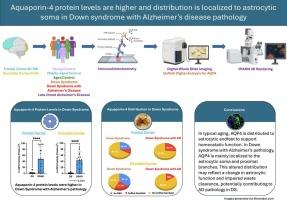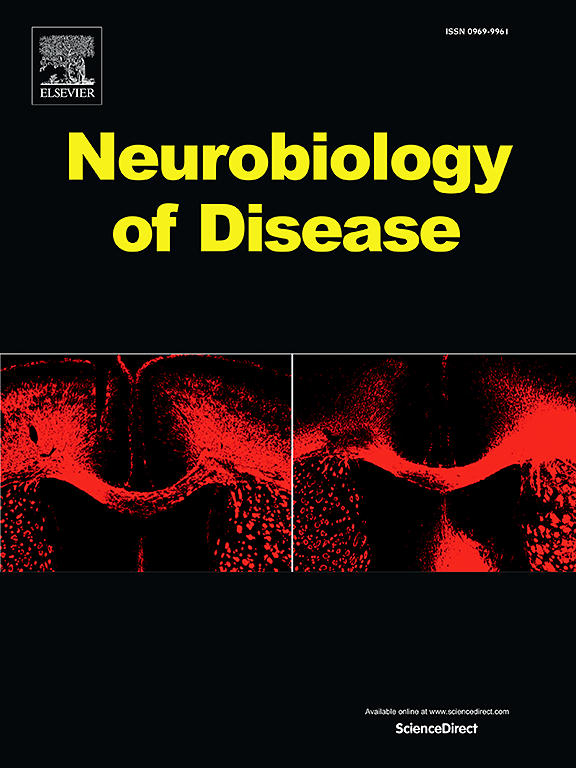Regional differences in astrocytic Aquaporin-4 protein levels and distribution in aging and Alzheimer's disease in down syndrome
IF 5.6
2区 医学
Q1 NEUROSCIENCES
引用次数: 0
Abstract
Aquaporin-4 (AQP4) is implicated in Alzheimer's disease (AD) pathology through its role in astrocytic function, cerebrovascular integrity, and beta-amyloid (Aβ) clearance. Impaired Aβ clearance in AD is linked to changes in AQP4 distribution; however, the role of AQP4 in AD associated with Down Syndrome (DS) is poorly understood. This study investigates AQP4 protein levels, its relationship with Aβ deposition, and distribution patterns in DS. Using human post-mortem brain sections from the frontal and occipital cortex, we analyzed AQP4 and Aβ levels in samples from neurotypical controls, DS, DS with AD (DSAD), and late onset AD (LOAD). Protein levels and distribution were assessed using immunohistochemistry and immunofluorescence with quantitative imaging tools. AQP4 protein levels were higher with age in both neurotypical control and DS groups, but not in the LOAD group. AQP4 and Aβ were positively correlated with age in the frontal cortex of all groups. AQP4 and Aβ were positively correlated with each other after adjusting for age in the frontal cortex in both the control and DS groups which was not observed in the occipital cortex. In the frontal cortex of both DS and DSAD, AQP4 was more frequently distributed to the soma and proximal branches and less to astrocytic endfeet compared to the control group, consistent with previous reports of impaired glymphatic clearance and perivascular regulation. These findings support a relationship between altered AQP4 protein levels and distribution, Aβ accumulation, and region-specific vulnerability in DS and AD.

星形细胞水通道蛋白-4蛋白水平和分布在衰老和唐氏综合征阿尔茨海默病中的区域差异。
水通道蛋白-4 (AQP4)通过其在星形细胞功能、脑血管完整性和β -淀粉样蛋白(Aβ)清除中的作用与阿尔茨海默病(AD)病理有关。AD中Aβ清除受损与AQP4分布的变化有关;然而,AQP4在与唐氏综合征(DS)相关的AD中的作用尚不清楚。本研究探讨了AQP4蛋白水平及其与Aβ沉积的关系以及DS的分布模式。利用人类死后大脑额叶和枕叶皮层切片,我们分析了神经正常对照组、DS、DS伴AD (DSAD)和晚发性AD (LOAD)样本中的AQP4和Aβ水平。使用免疫组织化学和免疫荧光定量成像工具评估蛋白质水平和分布。在神经正常对照组和DS组中,AQP4蛋白水平随年龄的增长而升高,但在LOAD组中没有。各组额叶皮质AQP4、Aβ与年龄呈正相关。经年龄调整后,对照组和DS组在额叶皮层AQP4与Aβ呈显著正相关,枕叶皮层AQP4与Aβ呈显著正相关。与对照组相比,在DS和DSAD的额叶皮质中,AQP4更频繁地分布于体细胞和近端分支,而较少分布于星形细胞终足,这与先前关于淋巴清除和血管周围调节受损的报道一致。这些发现支持了在DS和AD中AQP4蛋白水平和分布、a β积累以及区域特异性易感性之间的关系。
本文章由计算机程序翻译,如有差异,请以英文原文为准。
求助全文
约1分钟内获得全文
求助全文
来源期刊

Neurobiology of Disease
医学-神经科学
CiteScore
11.20
自引率
3.30%
发文量
270
审稿时长
76 days
期刊介绍:
Neurobiology of Disease is a major international journal at the interface between basic and clinical neuroscience. The journal provides a forum for the publication of top quality research papers on: molecular and cellular definitions of disease mechanisms, the neural systems and underpinning behavioral disorders, the genetics of inherited neurological and psychiatric diseases, nervous system aging, and findings relevant to the development of new therapies.
 求助内容:
求助内容: 应助结果提醒方式:
应助结果提醒方式:


